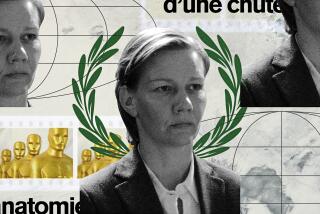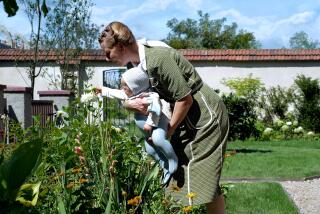NO REGRETS: The Life of Marietta Tree.<i> By Caroline Seebohm</i> .<i> Simon & Schuster: 448 pp., $27.50</i>
- Share via
Marietta Tree, beauteous, brilliant and bewitching, was a legendary salonniere and public figure, and few men or women who met her could resist falling under her spell.
Born in 1917, she was raised in a New England family whose 19th century manners and mores, like those of an Edith Wharton novel, restricted and limited the talents and aspirations of many privileged and adventurous pre-World War II women. But Tree burst free of these encumbrances and ended up with a solid record of substantive achievement. In her public life, she distinguished herself at the United Nations, in the Democratic Party and in addressing domestic urban problems. In her private life, she married CIA stalwart Desmond FitzGerald and Anglo-American aristocrat Ronald Tree, and she captured the hearts of Hollywood director John Huston, Adlai Stevenson and noted English architect and urban planner Richard Llewelyn-Davies.
Tree said she aspired to be a combination of Eleanor Roosevelt and Carole Lombard. How she managed this is detailed in “No Regrets,” a fascinating biography by Caroline Seebohm, author of numerous books, including “The Man Who Was Vogue: The Life of Conde Nast” and “The Last Romantics.”
In writing this biography, Seebohm had the cooperation of Tree’s family and friends and was given unlimited access to her letters, scrapbooks, notebooks and diaries. She has created a vivid, if somewhat breathless, portrait. While full of interesting insights and detail, the book does have a rather disingenuous title, meant, I suppose, to convey a certain insouciance. But “No Regrets” falls short of capturing the complex and textured life of this remarkable woman.
Tree was the granddaughter of the famous rector of Groton School, Endicott Peabody, and the only daughter of a clergyman, Malcolm Peabody. (She had four brothers.) The Peabodys were the epitome of New England aristocracy and intermarried extensively with their ilk. They were guided by a strong Puritan ethic of frugality, morality and duty. Bloodlines were far more important than money; any ostentatious display of wealth was greatly frowned on. Indeed, Marietta’s childhood seems almost Dickensian.
In trying to explain the New England mentality to me, my husband Archie used to recite this ditty: “Use it up / Wear it out / Make it do / Do without.” He understood Marietta’s roots and, incidentally, worshiped her from afar when he was a student at Groton. Archie was just one of the legions of gawky teenage Grotonians who lusted after Marietta, 5 feet 10 inches of blond, green-eyed and voluptuous beauty.
Many years later, when I met Marietta, I confess I was dazzled by her. She was not only stunning to look at--her pictures rarely do her justice--but she radiated star quality and elegant (never vulgar) sex appeal. Her manner and her conversation were inclusive; she had a generosity of spirit, great joie de vivre and, as one observer in the book comments, she “oozed class from every pore.”
And yet in “No Regrets,” we learn that the Marietta I saw was not always the real Marietta, that underneath the polished exterior was a woman beset with self-doubts, worried about finances and torn emotionally between husbands and lovers, between her desire for serious achievement and the lure of the glitterati. Most of all, she suffered from the conflict between her Puritan heritage and her luxurious and glamorous lifestyle.
Signs of this dichotomy began early. As a teenager, she was asked what sort of life she predicted for herself. According to Seebohm, instead of marriage and children, Marietta replied, “Parties, People and Politics.” And Seebohm quotes Tree’s response to a bishop who asked her what she wanted to be when she grew up: “I think I’m going to be a senator.”
“A senator of the United States?” he continued.
“Yes.”
“And how are you going to become a senator?”
“I’m going to be elected like everyone else.”
“And how are you going to manage all by yourself to be a senator?”
“Well, I’ll get the other boys to help me.”
She didn’t become a senator, but one remarkable “boy,” Adlai Stevenson, did help her become by 1961 the nationally recognized golden girl of the ruling Democratic Party. According to Seebohm, she was also “a brilliant hostess and power behind the throne. . . . She had been thrust upon a world stage that surpassed even her most grandiose childhood dreams. To cap the triumph, she was working alongside the man she idolized, loved and hoped would become more and more a part of her life.”
A lifelong Democratic activist, Tree worked closely with Stevenson in his presidential campaigns of 1952 and 1956, and when he became U.S. ambassador to the United Nations in 1960, Marietta was appointed to four U.N. committees. In 1964, she was promoted to the post of U.S. representative to the Trusteeship Council of the U.N. with the rank of ambassador and by all accounts did an excellent job. Her love affair with Adlai lasted until his death in 1965 of a heart attack, literally at her feet, as they were walking in London’s Grosvenor Square.
Throughout this period, she was still married to Ronald Tree, whom she had wed in 1947 after divorcing FitzGerald. The Trees began their married life at Ronnie’s palatial English estate, Ditchley Park, which had been restored and decorated by Ronnie’s first wife, the redoubtable Nancy Lancaster. As Seebohm describes this period, the problems Marietta encountered were not unlike those faced by the second wife in Daphne du Maurier’s “Rebecca,” but it was a heady existence nonetheless.
As chatelaine of a famous house with a staff of 30, Marietta discovered that “while she was titular head of a small city-state, like the British monarchy she had well defined but very limited constitutional powers. The young sons of estate workers came in every day to keep the fires stoked in all the fireplaces. There were horses in the stables and cars in the garages, looked after by estate employees. The flowers were arranged twice a week by the head gardener. There were two chefs (one French) and four kitchen maids. There was a still room, where all the breads, cakes and pastries were made. There was Ronnie’s treasured old Nanny Weir, who had brought up his two sons, in permanent lodgings on the top floor,” writes Seebohm.
But the advent of the Labor government and horrendous taxes forced Ronnie to sell Ditchley Park. The Trees then settled in New York, which Marietta loved but Ronnie decided was not for him. Subsequently, he built a showplace in Barbados, which was his primary residence until his death in 1976. Ronnie seems to have been understanding of Marietta’s relationship with Stevenson; according to Seebohm, Ronald Tree was bisexual and turned to some of his male friends for companionship.
Tree was not always an ideal mother, Seebohm writes; nonetheless she was devoted to her two talented daughters, noted writer Frances FitzGerald, who won a Pulitzer Prize in 1973 for “Fire in the Lake,” and Penelope Tree, who became a famous fashion model in her teens.
Marietta’s life has the makings of a TV miniseries and gives us a glimpse of a vanishing way of life. Marietta and her contemporaries, Katharine Graham and Pamela Harriman, were born into a world where women defined themselves by the men they married or, albeit discreetly, bedded. Graham, of course, made a dramatic transition when her husband’s suicide forced her to take over the Washington Post, and Harriman proved she could be more than an old-fashioned courtesan when she became Clinton’s ambassador to France.
Tree’s transition, however, was more complex. Both of her husbands were her avenues of escape from the stultifying effect of her New England upbringing, and her lovers broadened her horizons and challenged her, but she was never a courtesan. According to Seebohm, “she achieved her prominence through connections and hard work, not seduction.” In the world Marietta grew up in, sex was “experienced by people who wrestle with it in the unforgiving shadow of a Puritan God.”
One of the book’s most telling chapters is the description of Marietta’s death. In the spring of 1990, she had a recurrence of breast cancer (she had had a lumpectomy some years before). She disappeared for three days to have a mastectomy and told no one. Then she underwent chemotherapy, all the while continuing her regular busy schedule through 1990, but the cancer had metastasized and further treatment was to no avail.
Valiantly, she soldiered on through the summer of 1991, sharing her secret with no one but her daughter Frances. Thus, it was a great shock to her nearest and dearest to learn of her death in August 1991 at the age of 74. Many bemoaned the lack of closure and not being able to say goodbye. But that was the way Marietta wanted to go. She faced death as she had lived: with her head high, maintaining her New England stoicism and resolve to the very end.
More to Read
Sign up for our Book Club newsletter
Get the latest news, events and more from the Los Angeles Times Book Club, and help us get L.A. reading and talking.
You may occasionally receive promotional content from the Los Angeles Times.







